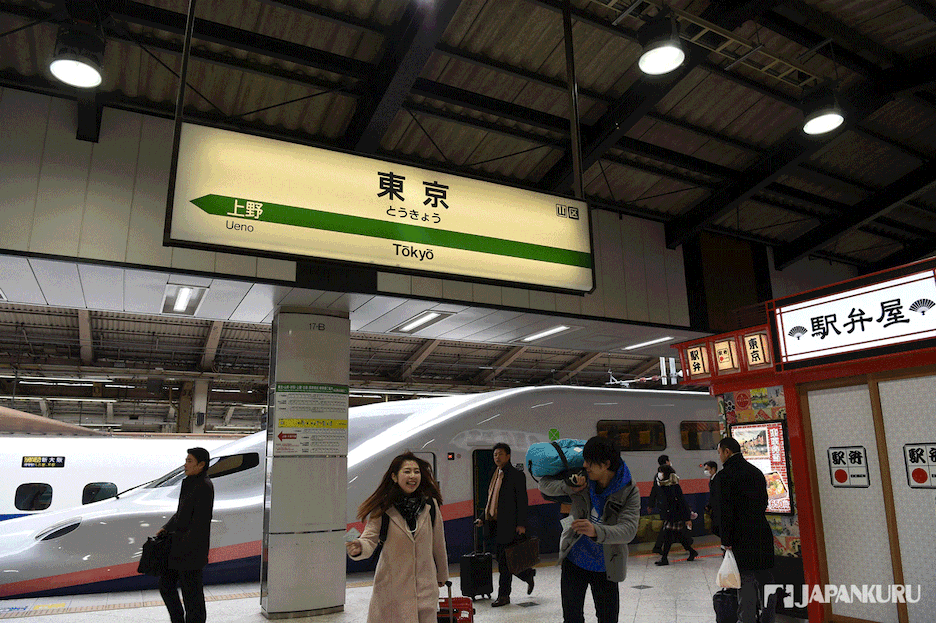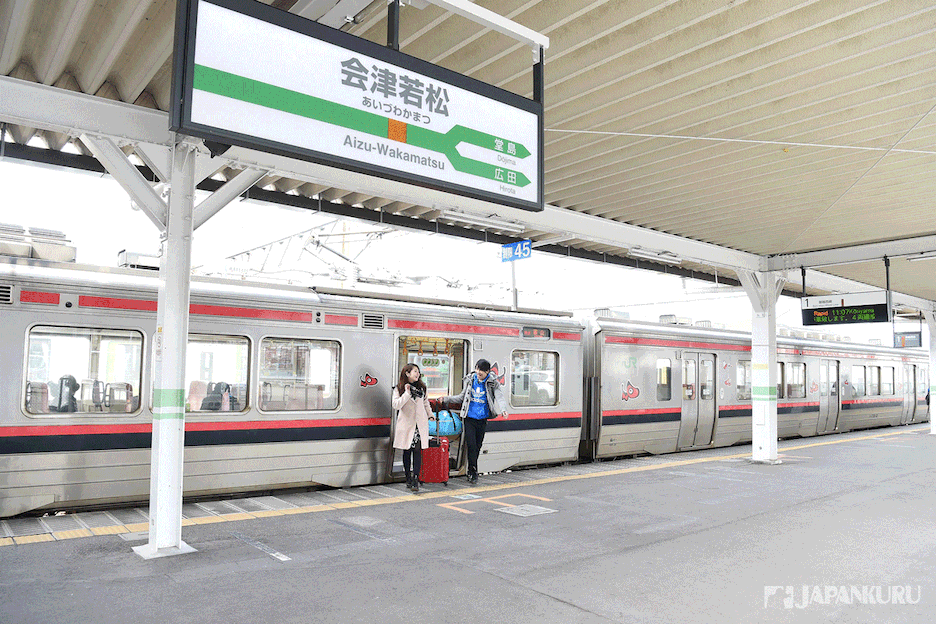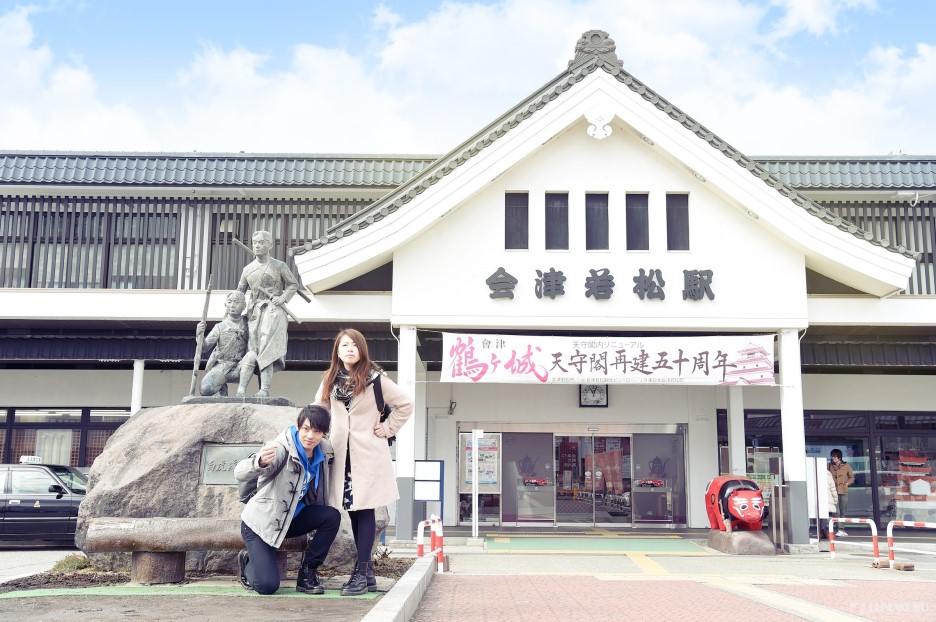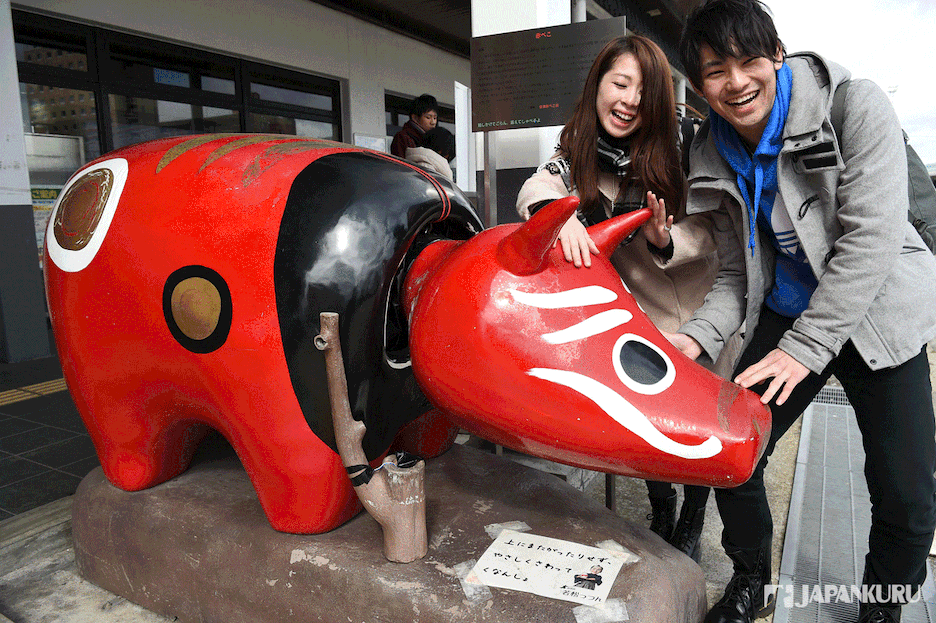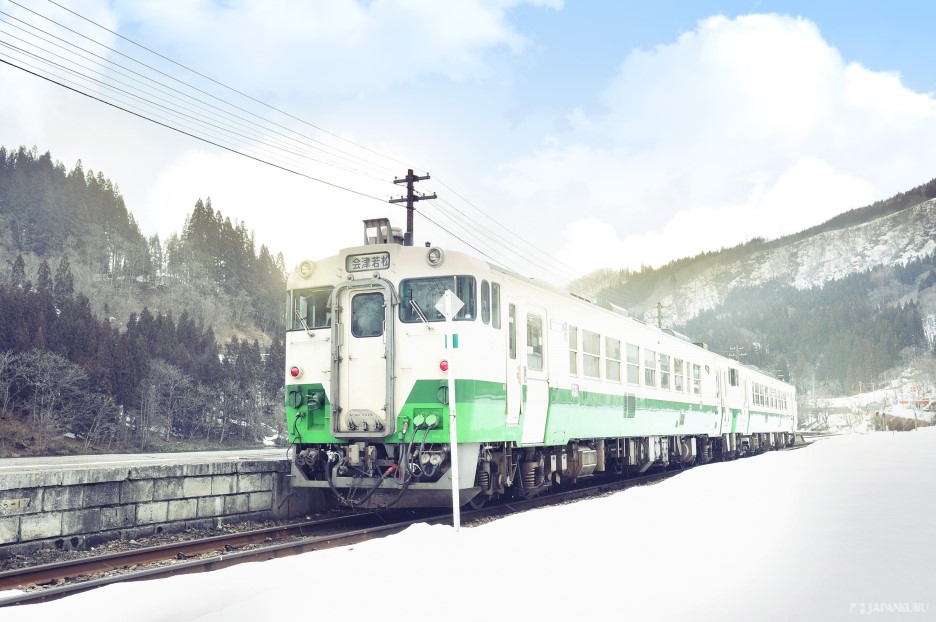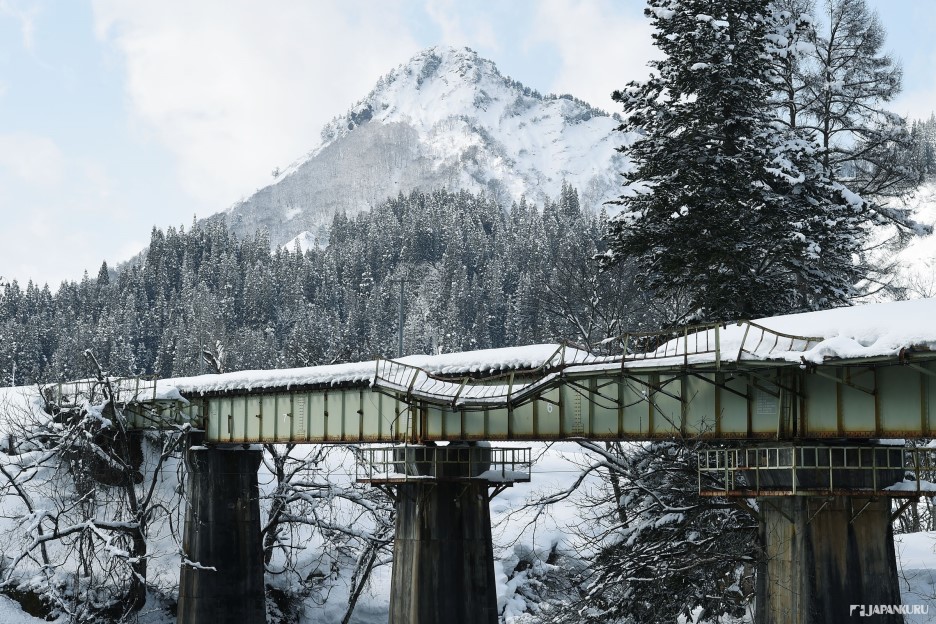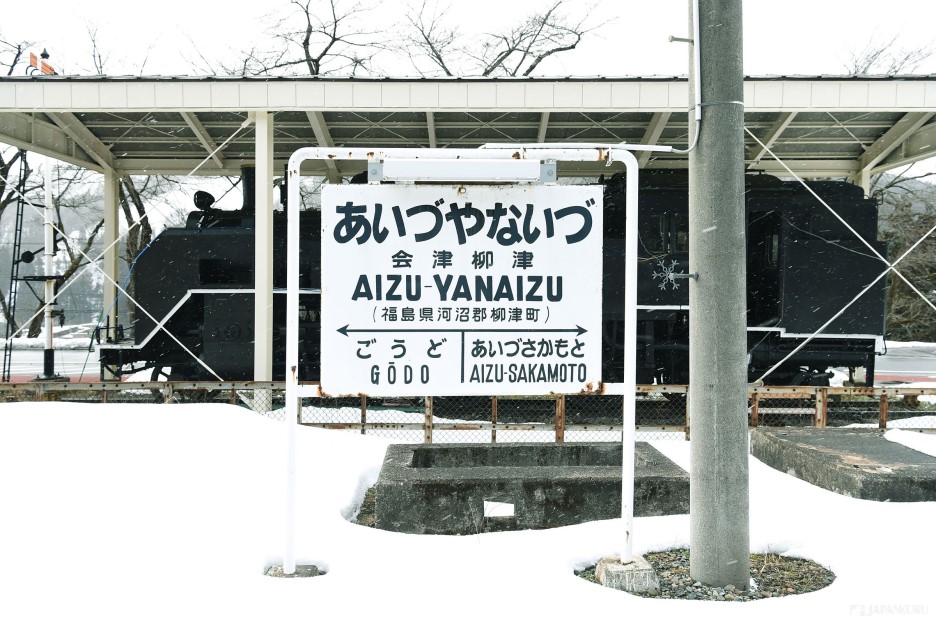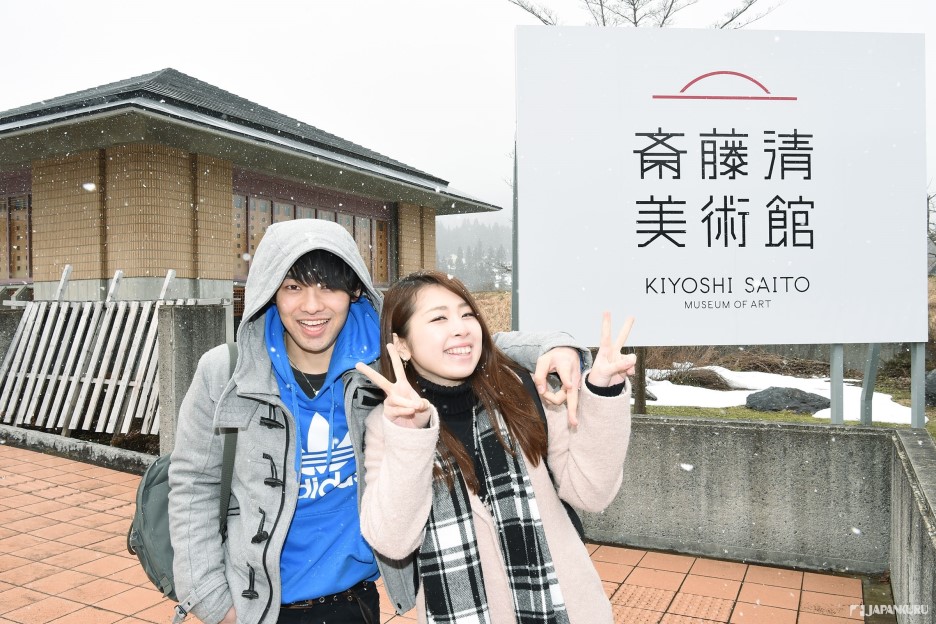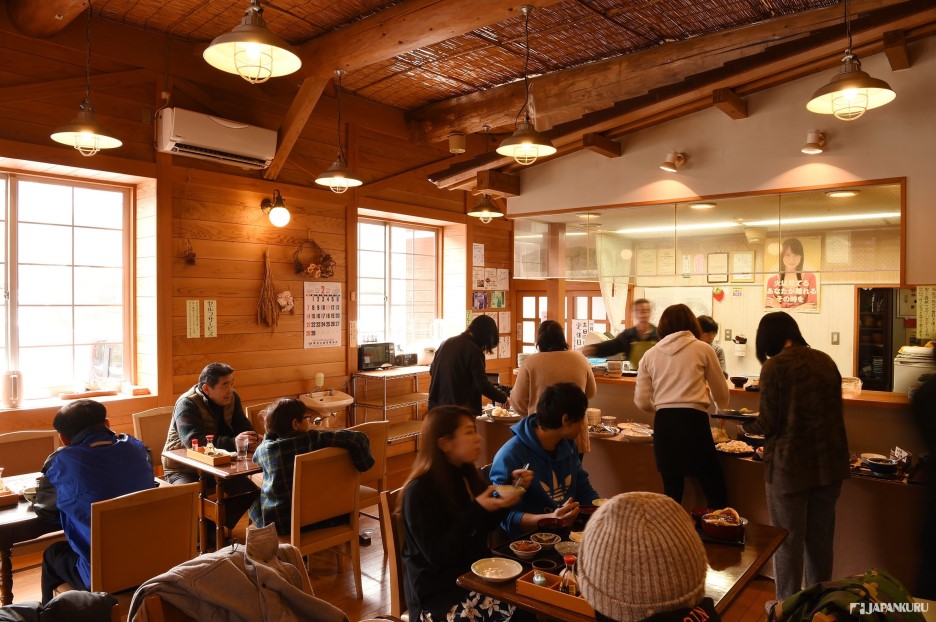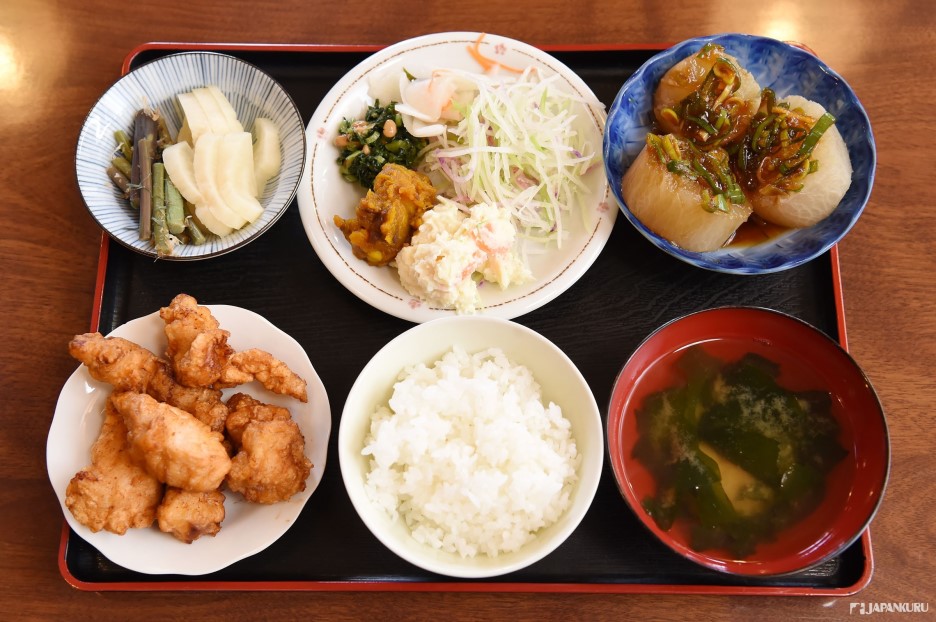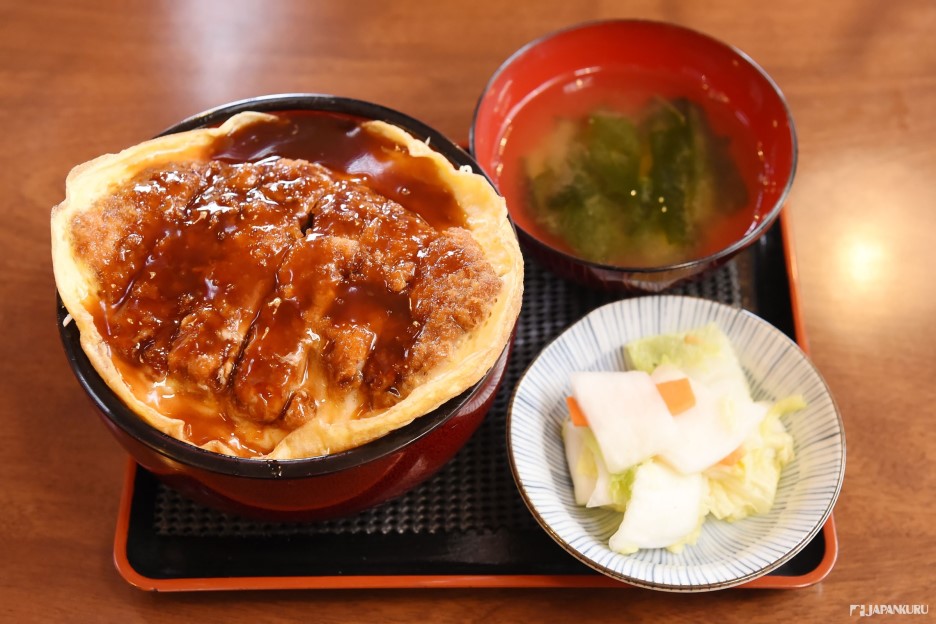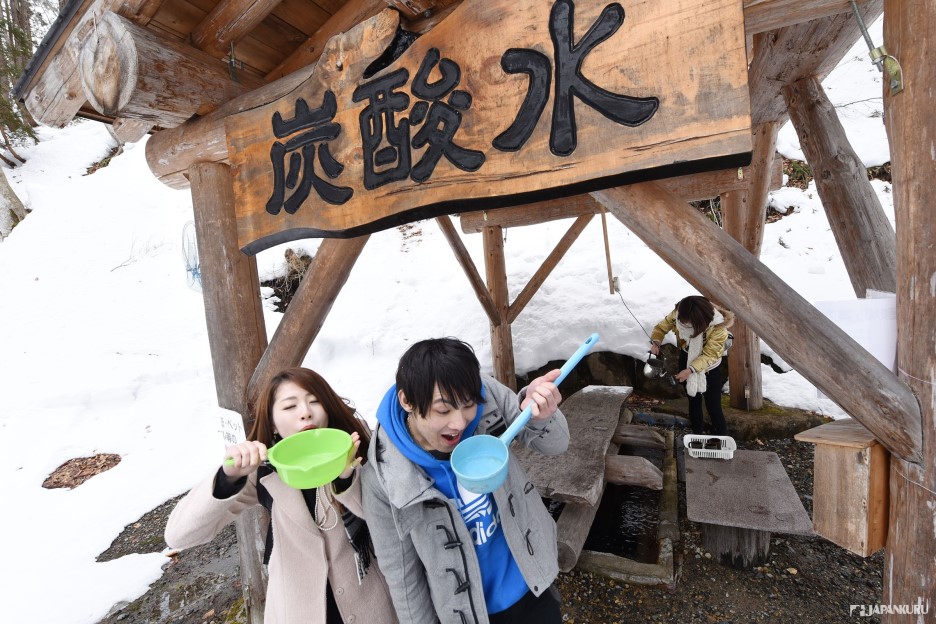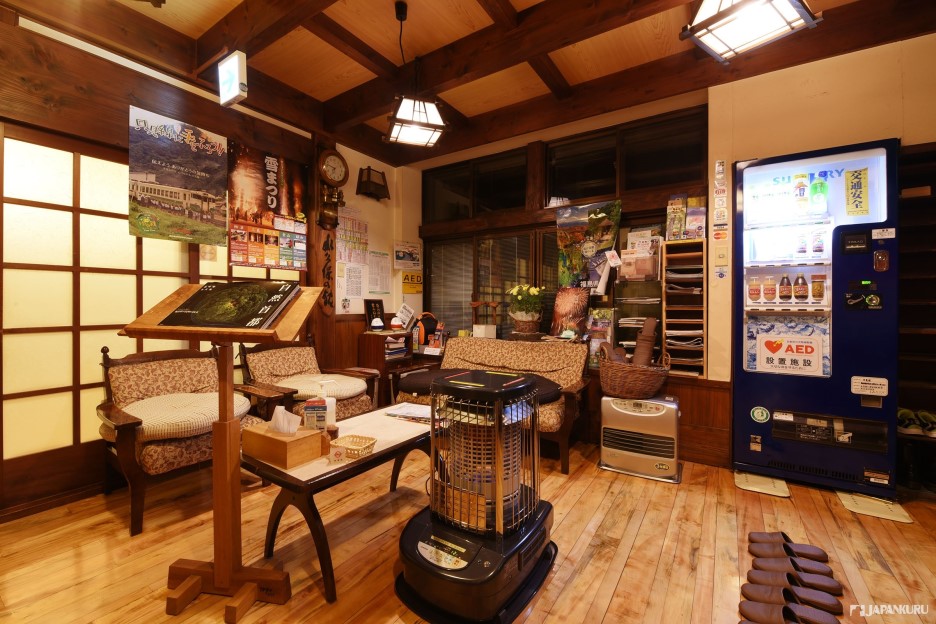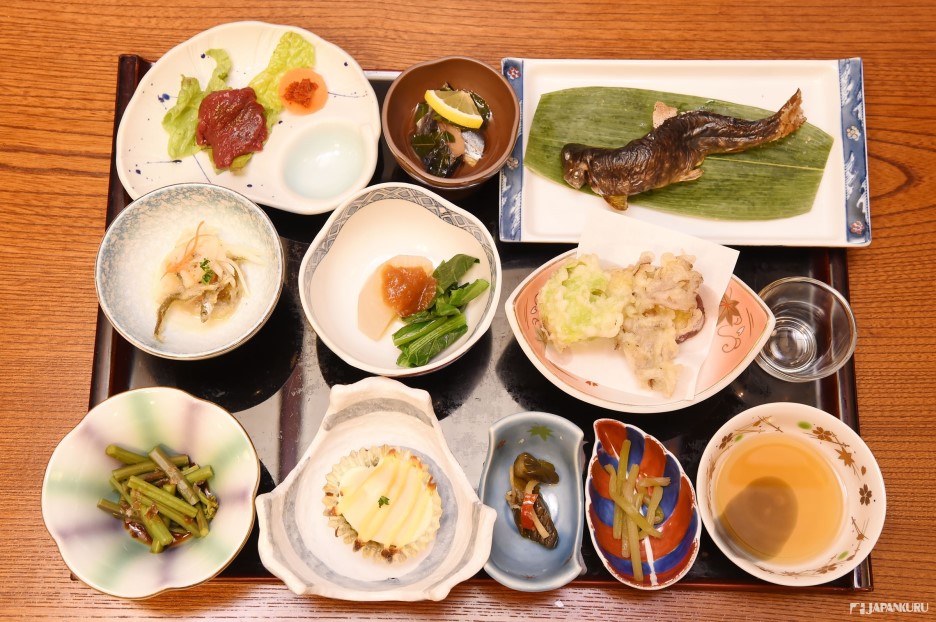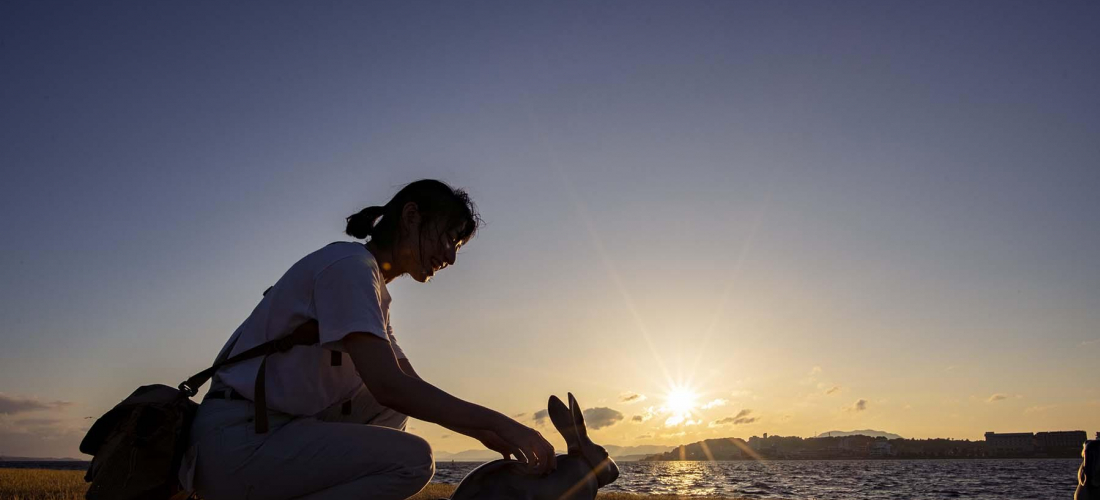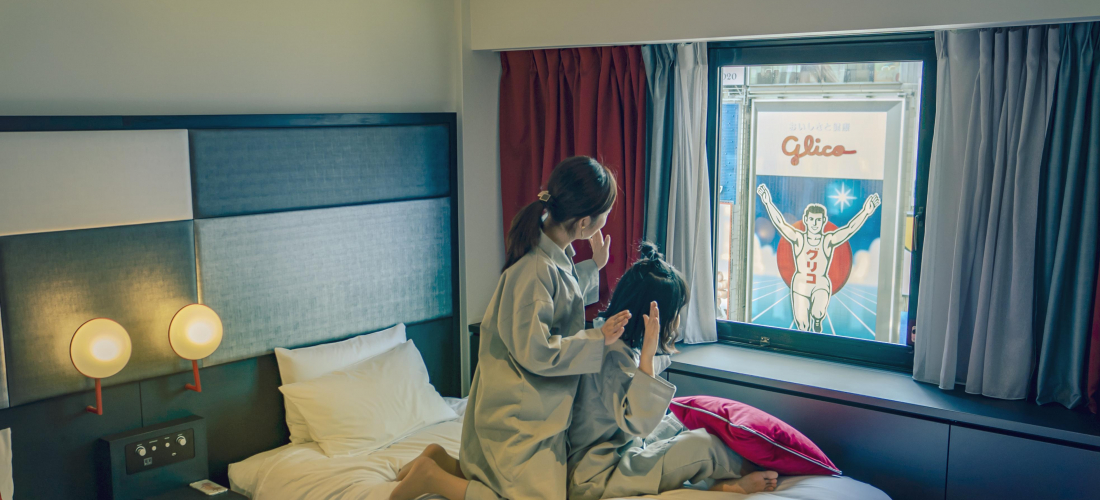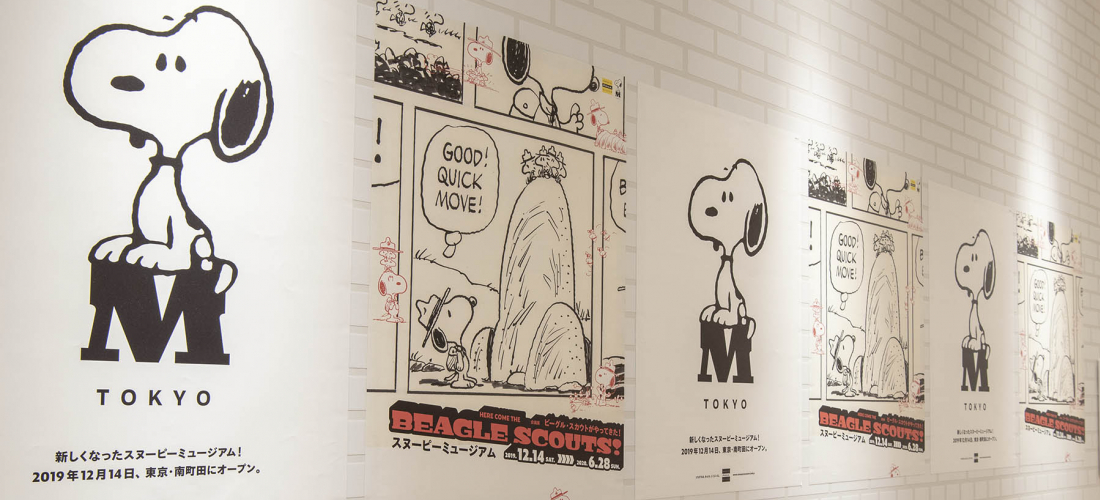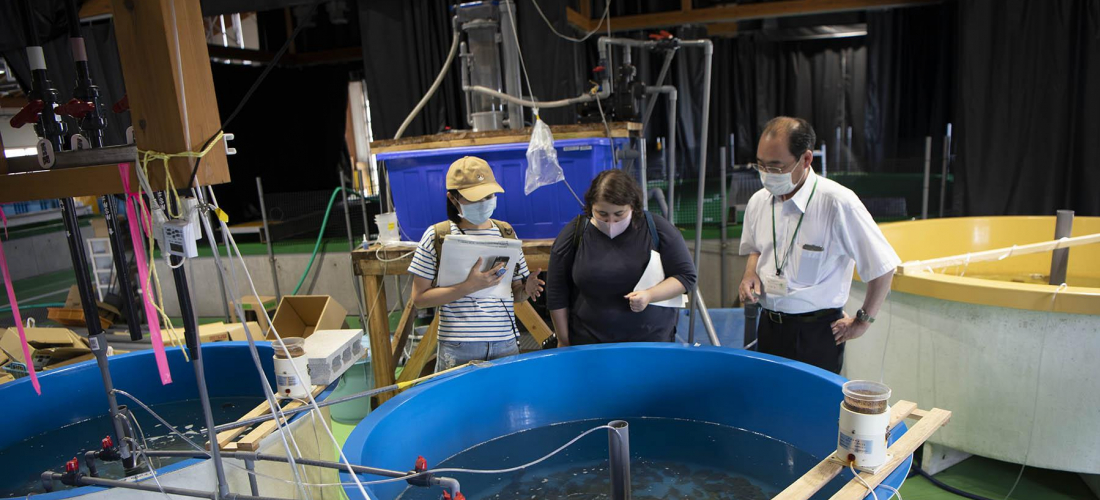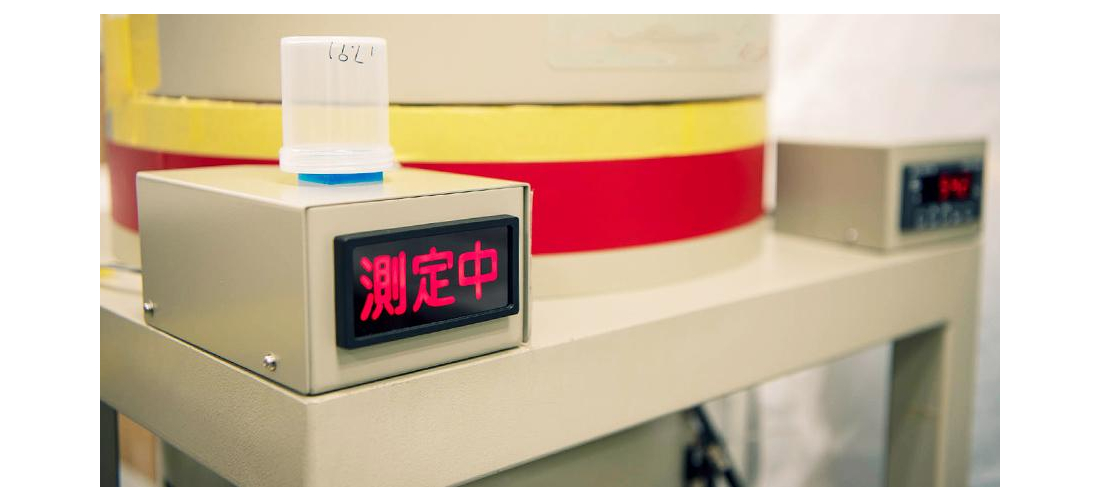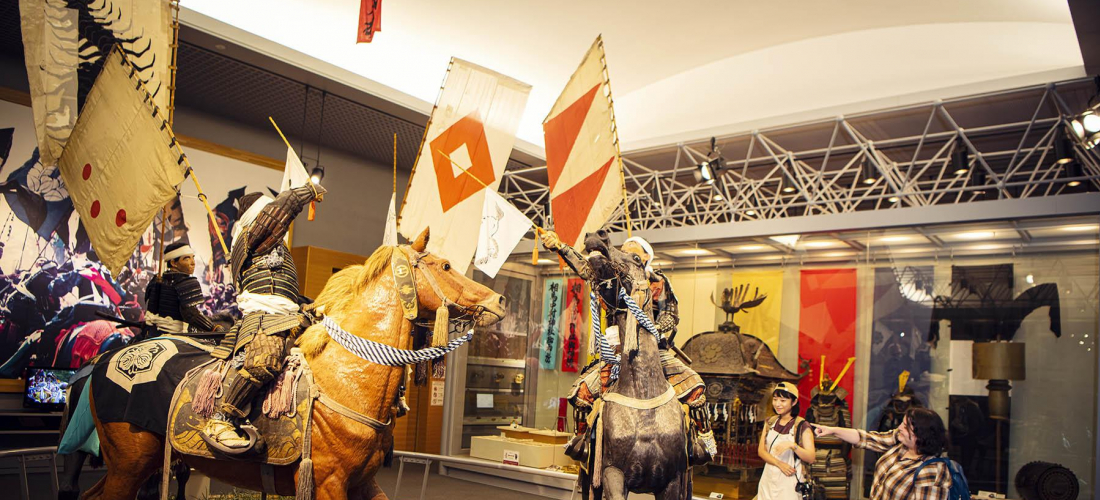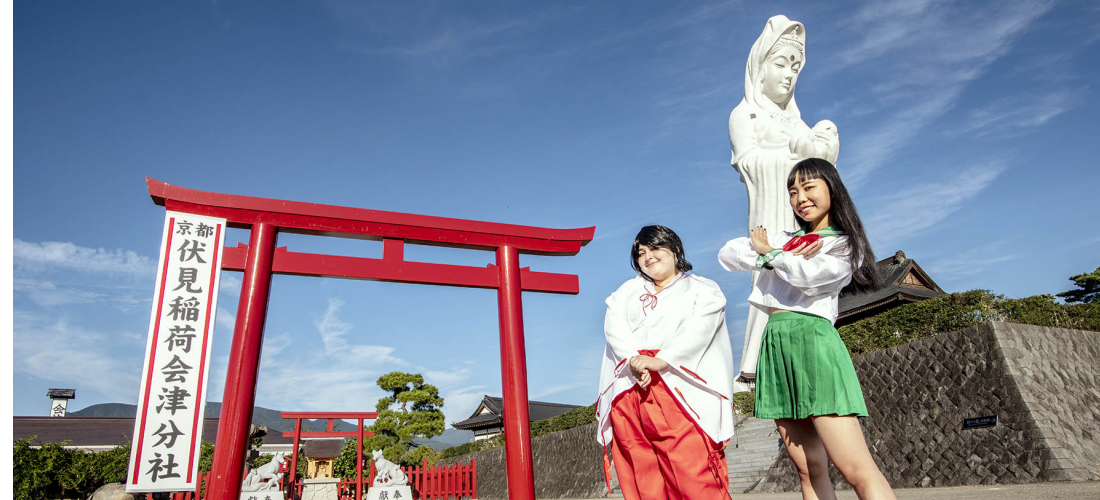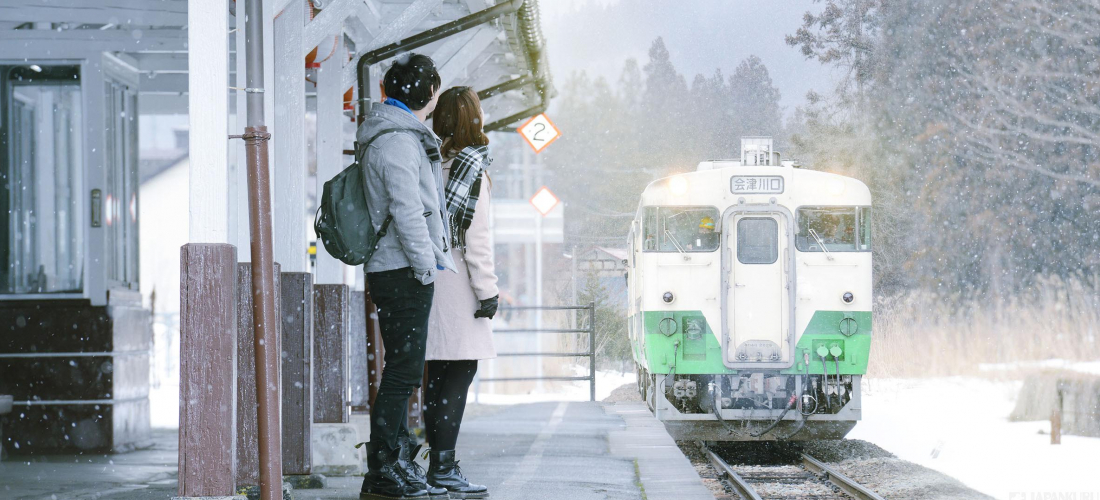
CONTENTS
Un Monde Blanc comme Neige
Nous avons pris nos valises pour la magnifique ville de Fukushima dans le Nord du Japon. Fukushima est couvert de neige pendant une longue période de l’année. Autant dire que les paysages enneigés vont vous ravir!
Embarquez sur la Ligne Tatami
Gare de Tokyo → Station de Koriyama
Via le Shinkansen Tōhoku, le trajet ne prend que 84 minutes pour rejoindre la station de Koriyama.
Station Koriyama → Station Aizu Wakamatsu
Arrivé à Koriyama, nous avons pris la correspondance sur la Ligne Banetsusai pour 70 minutes de plus direction Aizuka Wamatsu. Le trajet coûte seulement 1144 yens. Si vous souhaitez plus d’informations concernant les pass de train veuillez visiter la Page Web!
Station JR Aizu Wakamatsu
Aizu Wakamatsu est une ville largement connu pour ses usines de produits électroniques, de fibres ainsi que de meubles. La ville est également populaire pour ses cultures et magnifiques paysages!
‘Akabeko’ (赤べこ) est le boeuf rouge symbole de la région de Yanaizu. Il est dit qu’autrefois un très large séisme avait frappé Aizu et fait de nombreux dégâts et victimes. D’après la légende l’’Akabeko’ refusa de quitter les lieux de la construction du temple Enzō-ji et devint le symbole de la région. Cette légende a encore aujourd'hui une forte empreinte sur les locaux.
La Ligne Tadami, Un Train Local Splendide
La Ligne Tadami a ouvert en 1942 et est opérée par la compagnie JR. Elle parcourt 135 km joignant les stations d’Aizu Wakamatsu dans la préfecture de Fukushima et Koide dans la préfecture de Niigata, pour un total de 37 stations.
Encore aujourd’hui nous avons pu voir les dégâts causés par le tsunami de 2011. 7 stations étaient encore fermées lors de notre passage mais pas d’inquiétude des bus étaiet là pour faire la navette entre ces stations.
Premier arrêt → Aizu-Yanaizu
Depuis la station d’Aizu Wakamatsu le trajet ne prend qu’une petite heure. N’oubliez pas de descendre au 11ème arrêt. Il y avait très peu de monde à la station, nous avons donc profité pour se poser pour nous réchauffer. Notre voyage ne fait que commencer! Laissez-nous vous présenter les différents lieux que nous avons pu parcourir ;
❶ Goûtez au ‘Awa Manjū’
On dit qu’un moine aurait confectionné ces gâteaux cuits à la vapeur il y a 170 ans pour porter chance aux locaux. Ils sont devenus aujourd’hui une confiserie classique que l’on rapporte en souvenir à sa famille!
❷ Visitez le Musée Kiyoshi Saitō
Kiyoshi Saitō, né en 1907 était un peintre et graveur sur bois. Dans la plupart de ses oeuvres il faisait allusion à sa ville natale Aizu. Le musée est un bon moyen d’entre-apercevoir l’âme de la ville d’Aizu et ses paysages environnants.
⏰ : 9h – 17h (dernière admission à 16h30)
Fermé tous les Lundis (fermé le mardi en cas de jour férié la veille)
💴 : Adultes 510 yens ・Lycées et Etudiants à l’université 300 yens ・ Enfants 200 yens
🗾 : Situé à 20 minutes de marche de la station Aizu-Yanaizu
❸ Goûtez aux mets locaux au Restaurant ‘Kachan no Manmaya’
Tous les plats préparés ici sont confectionnés avec des produits locaux! C’est donc le meilleur endroit pour se faire une idée des saveurs de la région. Le nom du restaurant ‘Kachan no Manmaya’ (かあちゃんのまんまや, littéralement ‘A la table de Maman) annonce directement l’ambiance chaleureuse du lieu!
Ce buffet est extrêmement populaire auprès des locaux! Jetez donc un oeil au nombre de client lors de notre passage.
Le buffet de midi ne coûte d’ailleurs que 880 yens!! Oui, vous avez bien entendu SEULEMENT 880 yens!
Ce jour là nous avons choisi de goûter aux différentes salades, au poulet grillé ainsi qu’au tofu frit avec des pommes de terre.
Prochain arrêt → Aizu Kawaguchi
Afin de rejoindre la station d’Aizu Kawaguchi, nous avons dû emprunter le bus pour rejoindre la station suite aux dégâts causés par le tsunami de 2011.
Puisque nous avions pas mal de temps devant nous, nous avons décidé de nous arrêter dans un ‘Onsen’ (温泉 sources chaudes thermales). Ici l’eau gazeuse est douce, fait assez rare pour être noté! On dit que cette eau est parfaite pour cuisiner car elle est forte en fer, les jeunes femmes en raffolent!
🗾 : Situé à 10 minutes de marche de l’arrêt de bus Aizu Oshio
Dernier arrêt → Tadami
Encore une fois malheureusement nous n’avons pas pu emprunter le train pour rejoindre cette station! Le bus restait tout de même une bonne expérience.
Minshuku ‘Tadamisō’
Les ‘Minshuku’ (民宿) sont des chambres d’hôtes chez l’habitant. C’est un bon moyen de se familiariser avec l’histoire de la région et de faire de jolies rencontres.
💴 : 7500 yens par personne (chambre simple ・dîner et déjeuner compris)
7000 yens par personne (chambre double・dîner et déjeuner compris)
🗾 : En face de la station de Tadami
Page de réservation
Un Minshuku agréable
Nous avons vraiment été chanceux de trouver un endroit aussi confortable. Le service était bon et le personnel vraiment agréable!
Une ambiance chaleureuse
L’ambiance ici nous faisait nous sentir comme à la maison! Nous avons adoré ce logement.
Chambre traditionnelle avec tatami et ‘Kotatsu’ (こたつ, table avec couverture et chauffage pour se réchauffer durant l’hiver). La chambre était même équipée d’un réfrigérateur et d’un large évier!
Nous ne nous attendions pas à recevoir un repas aussi copieux dans un minshuku! Tout est d’ailleurs préparé par le propriétaire et laissez-nous vous dire que c’était un régal! Les nouilles faites maison étaient vraiment succulentes!
Nous n’avons pas fini de découvrir le Nord du Japon! Rejoignez-nous pour le Jour ❷ de notre voyage.
Restez connectés pour de nouveaux articles originaux tous les jours sur JAPANKURU🐶.
N'hésitez pas à nous suivre également sur nos réseaux Facebook et Instagram pour plus d'histoires japonaises!
Details
ACCESS:Station Aizu Wakamatsu
COMMENT
FEATURED MEDIA
VIEW MORE 
A New Tokyo Animal Destination: Relax & Learn About the World’s Animals in Japan
#pr #japankuru #anitouch #anitouchtokyodome #capybara #capybaracafe #animalcafe #tokyotrip #japantrip #카피바라 #애니터치 #아이와가볼만한곳 #도쿄여행 #가족여행 #東京旅遊 #東京親子景點 #日本動物互動體驗 #水豚泡澡 #東京巨蛋城 #เที่ยวญี่ปุ่น2025 #ที่เที่ยวครอบครัว #สวนสัตว์ในร่ม #TokyoDomeCity #anitouchtokyodome

Shohei Ohtani Collab Developed Products & Other Japanese Drugstore Recommendations From Kowa
#pr #japankuru
#kowa #syncronkowa #japanshopping #preworkout #postworkout #tokyoshopping #japantrip #일본쇼핑 #일본이온음료 #오타니 #오타니쇼헤이 #코와 #興和 #日本必買 #日本旅遊 #運動補充能量 #運動飲品 #ช้อปปิ้งญี่ปุ่น #เครื่องดื่มออกกำลังกาย #นักกีฬา #ผลิตภัณฑ์ญี่ปุ่น #อาหารเสริมญี่ปุ่น

도쿄 근교 당일치기 여행 추천! 작은 에도라 불리는 ‘가와고에’
세이부 ‘가와고에 패스(디지털)’ 하나면 편리하게 이동 + 가성비까지 완벽하게! 필름카메라 감성 가득한 레트로 거리 길거리 먹방부터 귀여움 끝판왕 핫플&포토 스폿까지 총집합!
Looking for day trips from Tokyo? Try Kawagoe, AKA Little Edo!
Use the SEIBU KAWAGOE PASS (Digital) for easy, affordable transportation!
Check out the historic streets of Kawagoe for some great street food and plenty of picturesque retro photo ops.
#pr #japankuru #도쿄근교여행 #가와고에 #가와고에패스 #세이부패스 #기모노체험 #가와고에여행 #도쿄여행코스 #도쿄근교당일치기 #세이부가와고에패스
#tokyotrip #kawagoe #tokyodaytrip #seibukawagoepass #kimono #japantrip

Hirakata Park, Osaka: Enjoy the Classic Japanese Theme Park Experience!
#pr #japankuru #hirakatapark #amusementpark #japantrip #osakatrip #familytrip #rollercoaster #retrôvibes #枚方公園 #大阪旅遊 #關西私房景點 #日本親子旅行 #日本遊樂園 #木造雲霄飛車 #히라카타파크 #สวนสนุกฮิราคาตะพาร์ค

🍵Love Matcha? Upgrade Your Matcha Experience With Tsujiri!
・160년 전통 일본 말차 브랜드 츠지리에서 말차 덕후들이 픽한 인기템만 골라봤어요
・抹茶控的天堂!甜點、餅乾、飲品一次滿足,連伴手禮都幫你列好清單了
・ส่องมัทฉะสุดฮิต พร้อมพาเที่ยวร้านดังในอุจิ เกียวโต
#pr #japankuru #matcha #matchalover #uji #kyoto #japantrip #ujimatcha #matchalatte #matchasweets #tsujiri #말차 #말차덕후 #츠지리 #교토여행 #말차라떼 #辻利抹茶 #抹茶控 #日本抹茶 #宇治 #宇治抹茶 #日本伴手禮 #抹茶拿鐵 #抹茶甜點 #มัทฉะ #ของฝากญี่ปุ่น #ชาเขียวญี่ปุ่น #ซึจิริ #เกียวโต

・What Is Nenaito? And How Does This Sleep Care Supplement Work?
・你的睡眠保健品——認識「睡眠茶氨酸錠」
・수면 케어 서플리먼트 ‘네나이토’란?
・ผลิตภัณฑ์เสริมอาหารดูแลการนอน “Nenaito(ネナイト)” คืออะไร?
#pr #japankuru #sleepcare #japanshopping #nenaito #sleepsupplement #asahi #睡眠茶氨酸錠 #睡眠保健 #朝日 #l茶胺酸 #日本藥妝 #日本必買 #일본쇼핑 #수면 #건강하자 #네나이토 #일본영양제 #อาหารเสริมญี่ปุ่น #ช้อปปิ้งญี่ปุ่น #ร้านขายยาญี่ปุ่น #ดูแลตัวเองก่อนนอน #อาซาฮิ

Japanese Drugstore Must-Buys! Essential Items from Hisamitsu® Pharmaceutical
#PR #japankuru #hisamitsu #salonpas #feitas #hisamitsupharmaceutical #japanshopping #tokyoshopping #traveltips #japanhaul #japantrip #japantravel

Whether you grew up with Dragon Ball or you just fell in love with Dragon Ball DAIMA, you'll like the newest JINS collab. Shop this limited-edition Dragon Ball accessory collection to find some of the best Dragon Ball merchandise in Japan!
>> Find out more at Japankuru.com! (link in bio)
#japankuru #dragonball #dragonballdaima #animecollab #japanshopping #jins #japaneseglasses #japantravel #animemerch #pr

This month, Japankuru teamed up with @official_korekoko to invite three influencers (originally from Thailand, China, and Taiwan) on a trip to Yokohama. Check out the article (in Chinese) on Japankuru.com for all of their travel tips and photography hints - and look forward to more cool collaborations coming soon!
【橫濱夜散策 x 教你怎麼拍出網美照 📸✨】
每次來日本玩,是不是都會先找旅日網紅的推薦清單?
這次,我們邀請擁有日本豐富旅遊經驗的🇹🇭泰國、🇨🇳中國、🇹🇼台灣網紅,帶你走進夜晚的橫濱!從玩樂路線到拍照技巧,教你怎麼拍出最美的夜景照。那些熟悉的景點,換個視角說不定會有新發現~快跟他們一起出發吧!
#japankuru #橫濱紅磚倉庫 #汽車道 #中華街 #yokohama #japankuru #橫濱紅磚倉庫 #汽車道 #中華街 #yokohama #yokohamaredbrickwarehouse #yokohamachinatown

If you’re a fan of Vivienne Westwood's Japanese designs, and you’re looking forward to shopping in Harajuku this summer, we’ve got important news for you. Vivienne Westwood RED LABEL Laforet Harajuku is now closed for renovations - but the grand reopening is scheduled for July!
>> Find out more at Japankuru.com! (link in bio)
#japankuru #viviennewestwood #harajuku #omotesando #viviennewestwoodredlabel #viviennewestwoodjapan #비비안웨스트우드 #오모테산도 #하라주쿠 #日本購物 #薇薇安魏斯伍德 #日本時尚 #原宿 #表參道 #japantrip #japanshopping #pr

Ready to see TeamLab in Kyoto!? At TeamLab Biovortex Kyoto, the collective is taking their acclaimed immersive art and bringing it to Japan's ancient capital. We can't wait to see it for ourselves this autumn!
>> Find out more at Japankuru.com! (link in bio)
#japankuru #teamlab #teamlabbiovortex #kyoto #kyototrip #japantravel #artnews
Photos courtesy of teamLab, Exhibition view of teamLab Biovortex Kyoto, 2025, Kyoto ® teamLab, courtesy Pace Gallery

Japanese Makeup Shopping • A Trip to Kamakura & Enoshima With Canmake’s Cool-Toned Summer Makeup
#pr #canmake #enoshima #enoden #에노시마 #캔메이크 #japanesemakeup #japanesecosmetics

⚔️The Robot Restaurant is gone, but the Samurai Restaurant is here to take its place. Check it out, and don't forget your coupon!
🍣신주쿠의 명소 로봇 레스토랑이 사무라이 레스토랑으로 부활! 절찬 쿠폰 발급중
💃18歲以上才能入場的歌舞秀,和你想的不一樣!拿好優惠券去看看~
#tokyo #shinjuku #samurairestaurant #robotrestaurant #tokyotrip #도쿄여행 #신주쿠 #사무라이레스토랑 #이색체험 #할인이벤트 #歌舞伎町 #東京景點 #武士餐廳 #日本表演 #日本文化體驗 #japankuru #japantrip #japantravel #japanlovers #japan_of_insta

Japanese appliance & electronics shopping with our KOJIMA x BicCamera coupon!
用JAPANKURU的KOJIMA x BicCamera優惠券買這些正好❤️
코지마 x 빅 카메라 쿠폰으로 일본 가전 제품 쇼핑하기
#pr #japankuru #japanshopping #kojima #biccamera #japaneseskincare #yaman #dji #osmopocket3 #skincaredevice #日本購物 #美容儀 #相機 #雅萌 #日本家電 #일본여행 #면세 #여행꿀팁 #일본쇼핑리스트 #쿠폰 #일본쇼핑 #일본브랜드 #할인 #코지마 #빅카메라 #japankurucoupon

